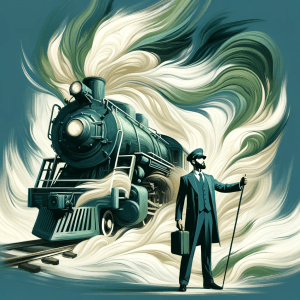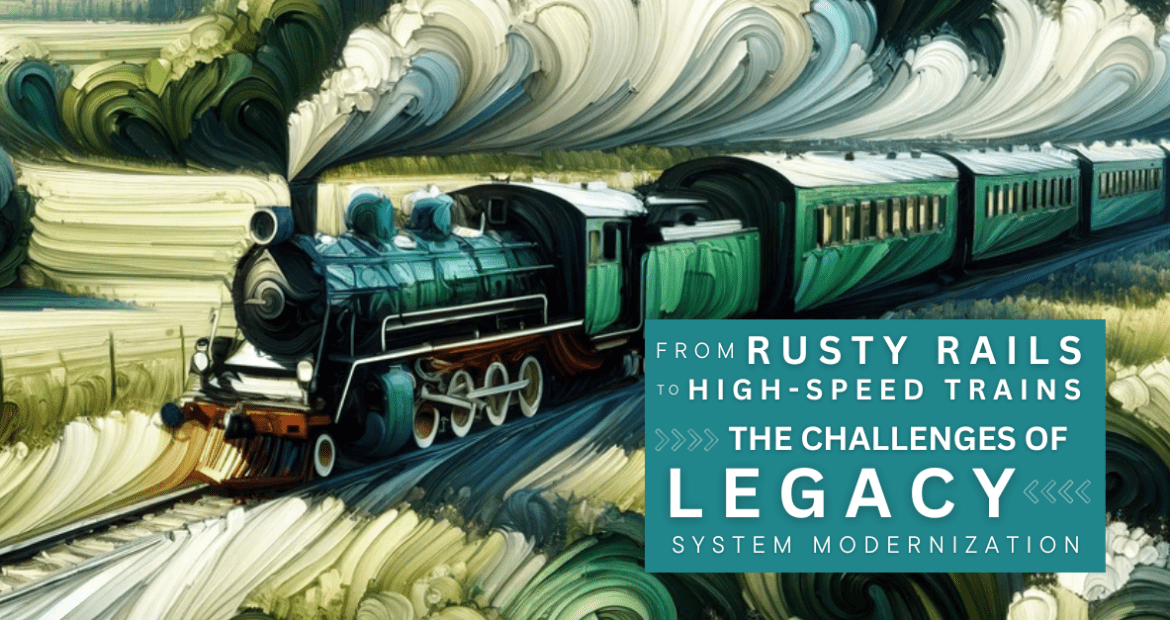Let’s face it: in the world of enterprise applications, ‘out with the old, in with the new’ is easier said than done, especially when it comes to modernizing legacy applications. It’s like being charmed by the latest smartphone but then realizing you have years of photos and messages to transfer. For businesses, especially (but certainly not exclusively) those nestled comfortably on platforms like Oracle Forms, deciding to upgrade these systems is like choosing to modernize a train while it’s running. High stakes? Absolutely.
In this post, we’re taking a look into why modernizing existing applications is often hard, with complexities that differ from those found when building new systems from scratch. The reasons are varied—from the delicate handling of legacy data to the intricate revamping of the architecture, all while ensuring the train never halts. But don’t despair. Of course, there absolutely is light at the end of the tunnel.
The Constantly Running Train:
Legacy applications are like trains that never stop. They’re crucial components of your organization, continuously delivering services and functions vital to the business. They carry the ‘cargo’ of valuable data and processes, essentially the lifeblood of your business. Modernizing these applications requires a meticulous approach to ensure no interruption in the flow of this invaluable cargo.

The Challenges of Legacy System Modernization
Ok, so what are these challenges exactly? Well, modernizing isn’t just a simple upgrade; it often demands precision, careful planning, and a keen eye for detail. From revamping the fundamental infrastructure to ensuring the seamless transition of critical data and processes, each step has potential pitfalls. And it’s not just about the technology – it’s about the people who use it. Striking the right balance between innovation and continuity can be difficult.

Replacing the Tracks:
Modernization projects often require changes to the underlying infrastructure of application. Think of this like the tracks that trains run on. To modernize the tracks themselves can be challenging. It might involve upgrading the databases, servers, and other foundational elements, requiring precision and caution. Any misstep during this stage can result in significant downtime or loss of data, causing substantial harm to the organization’s operations.

Moving the Cargo:
Your data and business processes are at the heart of any application. Think of them as the cargo. Shifting these without service interruption is a bit like transferring freight between two high-speed trains, aligning them perfectly to ensure no loss. The transformation of data structures, adaptation of processes, and the seamless migration of data from old to new are critical tasks that demand planning and careful execution.

Engine Revamp:
How about your business logic? Modernizing the application’s core—its algorithms and business logic—is equivalent to upgrading the train’s engine on the go. The refactoring or rewriting of code, coupled with the implementation of new features, demands rigorous testing and validation to ensure the ongoing stability and reliability of the system. You definitely want to make sure any newly modernized system takes care of all those years of careful tweaking and adjusting to your way of doing business.

Changing Established Routes
And finally, what about your users?
They’ve grown accustomed to the rhythm of their journey – the familiar stops, the timings, and even the quirks of the old train. Now, imagine introducing changes to this routine: new routes, altered schedules, or even a different type of train. Such changes, while potentially beneficial in the long run, can initially be met with discomfort and resistance. Successfully managing this transition requires more than just implementing new technology; it demands guiding the passengers – the users – through this new journey with care, ensuring they understand and appreciate the benefits of the new route, while minimizing the disruption to their familiar travels.
Why Not Start Afresh?
Ok, so the challenges are clear. We need to change the tracks, move the cargo, refurbish the engine, and ensure our passengers are happy. So why not just start from scratch with a brand spanking new system? Sounds tempting, right? But it’s not as simple as it seems.
Think about it: legacy systems aren’t just any old software; they’re the foundation that businesses have been building on for years, sometimes decades. These systems are like a treasure trove of knowledge, customizations, and special features tailored just right for the business.
Deciding to start over from square one? You risk losing all those finely tuned, business-critical details that took years to get just right. Plus, the chance of messing up what’s already working well is pretty high.
And let’s not forget about the time and effort it takes to build a system that’s as good as what you already have. It’s like trying to recreate a family recipe without the secret ingredient – it’s going to take a lot of trial and error to get it just right. This isn’t just about the tech stuff; it’s about regaining the trust and familiarity of your users, which is a whole journey in itself.
So, what’s the smarter move? Completely discarding a legacy system is not a practical or low-risk option.
Instead, the focus is better placed on strategically modernizing the existing system. This involves careful planning, incremental changes, and running old and new components in parallel to minimize disruptions. Such an approach allows organizations to retain the invaluable aspects of their legacy systems while progressively introducing improvements and modern functionalities, thereby reducing risk and ensuring a smoother transition.
At Insum, we call this the hybrid approach, and it’s helped us execute countless legacy modernization projects successfully.
The Oracle APEX Advantage in Navigating Modernization Challenges
Because of the complexities of modernizing legacy systems, you’ll want to consider a solid solution that tackles these challenges head-on. Enter Oracle APEX – it’s kind of like a Swiss Army knife, packed with all sorts of features you didn’t know you’d need but do. Oracle APEX is a platform uniquely equipped to address the multitude of challenges presented in the modernization journey.
More Passengers, More Speed (Scalability and Performance)
Legacy systems often struggle with scalability and performance issues, especially as business grows or user demands evolve. In modernization efforts, it’s essential to adopt platforms that not only resolve these issues but also cater to future growth. Oracle APEX’s scalability ensures that modernized applications can handle increased loads and user numbers without compromising on performance. This aspect is critical for businesses looking to expand or adapt to fluctuating demands without the need for constant reengineering of their applications. With Oracle APEX, you can carry more passengers, faster than before.
Rapid Application Development
When it comes to legacy application modernization, time is often a critical factor. Businesses need to update their systems quickly to keep pace with evolving market demands and technological advancements. Rapid Application Development is pivotal in this context as it significantly reduces development time and accelerates the deployment of modernized applications. Oracle APEX’s RAD capabilities allow businesses to swiftly respond to changing needs, minimize downtime during transitions, and reduce the time to market for new features. This speed is crucial for maintaining competitive advantage and ensuring business continuity during the modernization process.
Seamless Data Integration
Legacy applications typically operate within complex ecosystems, often interacting with various databases and external systems. During any modernization project, seamless data integration is paramount to ensure uninterrupted business operations. Oracle APEX’s ability to integrate efficiently with different data sources simplifies the modernization process.
Enhanced Security
Security concerns are often magnified during the modernization of legacy applications, as outdated systems often have vulnerabilities that can be exploited. Enhanced security is therefore a crucial element in modernization efforts. Oracle APEX’s built-in security features offer robust protection against common threats, ensuring the integrity and confidentiality of business data. This enhanced security is vital for maintaining trust, complying with regulations, and protecting sensitive information during and after the transition to modernized systems.
Enhanced User Experience:
Beyond the operational advantages, Oracle APEX facilitates the creation of modern, user-friendly interfaces. It aids in refurbishing the compartments of your train, offering enhanced user experiences, which are integral to meeting the evolving expectations of today’s users. The rejuvenated interfaces not only elevate user satisfaction but also contribute to improved productivity and efficiency.
Agile Development:
Oracle APEX promotes agile development, allowing for rapid application development and deployment. This means the modernization can occur in incremental steps, reducing downtime, and allowing for continuous feedback and improvement. The agility of the platform means your organization can adapt more quickly to changing needs and emerging opportunities.
Leveraging Oracle APEX to Modernize Oracle Forms
In addition to the advantages listed above, when it comes to modernizing Oracle Forms applications specifically, the case for Oracle APEX becomes even more compelling.

Preserving the Cargo
(Data Continuity):
One of the standout advantages of utilizing Oracle APEX is the preservation and continuity of data. The cargo—your invaluable data—remains secure within the same database, eliminating the risks associated with moving data and ensuring seamless access and integration. This continuity safeguards the organization’s data integrity and maintains the flow of information without disruption.

Infrastructure Integrity:
With Oracle APEX, there may be opportunities to retain or only slightly modify the existing infrastructure. This means the tracks on which your technological train runs may not need a complete overhaul. The capability to leverage existing infrastructure reduces the complexities and potential hurdles during the transition, providing a more sstraightforward modernization process.

Empowering the Existing Team:
The shift to Oracle APEX is not about reinventing the wheel but about enhancing it. Because Oracle APEX runs on PL/SQL just like Oracle Forms, existing teams can easily adapt to and support the new system, removing the need to onboard new train engineers to keep the operations running smoothly. The ease of adaptation ensures that your team can continue to focus on innovation and optimization without the steep learning curves associated with new technologies.
Choosing the Right Conductor for Your Journey
Selecting the right technology to modernize your legacy applications is just one part of the equation. The other, equally crucial, is finding the right partner to steer this transformation. Even if you’ve got the latest high-tech train, without an expert conductor, where are you really going? The same holds true for technology upgrades. A knowledgeable and experienced partner is like the conductor of your train, navigating through complex tracks, ensuring every move is precise, and avoiding potential pitfalls. They’re not just implementers; they’re your strategists, advisors, and the ones who can foresee challenges and navigate them skillfully. This partnership is key to not just adopting new technology but adapting it seamlessly into your organization’s unique landscape.

Embark on a journey with Insum
The path to modernizing legacy applications is akin to navigating a complex railway network: it requires not just the right tools but also the guidance of a skilled navigator. This is where partnering with Insum makes all the difference. As Oracle specialists, OCI and Oracle APEX experts, we have a rich history of guiding clients through the intricacies of modernization projects. We understand the balance between the old and the new, ensuring a smooth transition that respects your legacy while embracing the future.
Our team is adept at tackling the unique challenges each organization faces, offering tailored solutions that align with your specific needs. Whether it’s revamping your infrastructure, ensuring seamless data integration, enhancing security, or improving user experience, we’re here to ensure that every aspect of your modernization journey is handled with the utmost precision and care.
So, if you’re looking to modernize your legacy applications and need a partner who can navigate this journey with expertise and confidence, look no further. Let’s work together to keep your business train not just running but evolving into a more efficient, modern, and user-friendly version of itself.

